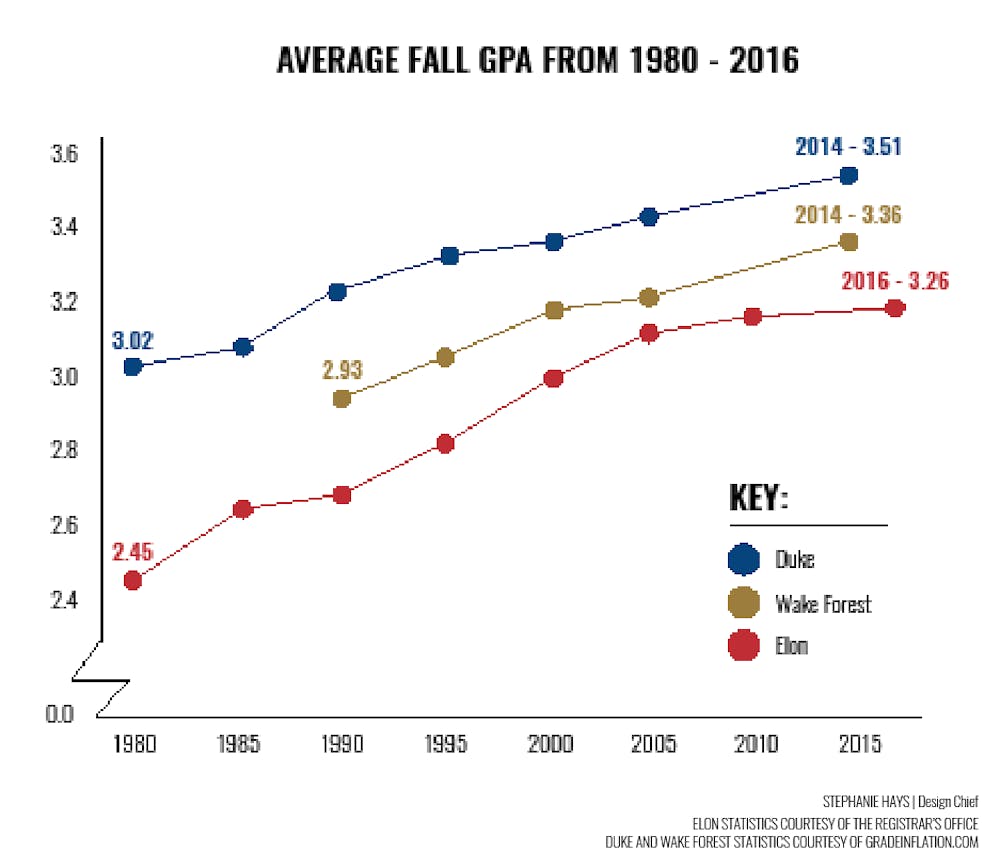Analysis from the Registrar’s office shows that professors at Elon University have become more frugal with distributing higher grades over time.
Grade distribution for fall 2016 semester shows that 29 percent of Elon undergraduates, or 7,590 students, received an ‘A’ grade. The overall GPA for the fall was a 3.26, one of the highest in Elon history.
The report from the Registrar’s office said 47 percent of undergraduates received either an ‘A’ or an ‘A-’ average, which denotes “distinguished performance” according to the student handbook. Eighty-one percent of students received a B- average or above.
Fall GPAs have risen sharply since the university began tracking overall semester GPAs for undergraduates. In 1978, the average fall GPA was a 2.37. By 2000, it had become a 3.00 and had risen steadily to a 3.26 over the past 17 years.
The issue of grade inflation at Elon has been addressed in the past. In the Elon Magazine in the spring of 2009, Elon President Leo Lambert penned a letter titled ‘Who is an ‘A’ student today?’ In the letter, Lambert notes, “The grade inflation discussion at Elon coincides with other campus initiatives to increase academic challenge to keep pace with the rising quality of the student body. Addressing the grading issue is a natural outgrowth of those efforts.”
Since this letter, however, overall GPAs have continued to rise.
According to junior David Nunamaker, getting good grades at Elon hasn’t been a challenge for him.
“I’d definitely say I’ve only ever had one or two truly challenging classes,” he said. “Rarely do you need to do all of the work to get an A in the class.”
But just because overall GPAs are on the rise, doesn’t mean everyone feels it. For junior Emily Current, her classes are only getting harder.
“Teachers expect a lot from students and often forget that we have a lot of other classes,” she said. “It’s definitely getting harder and harder to get As even though it’s more expected.”
Grade inflation hasn’t just been an issue at Elon. According to Inside Higher Ed, grades continue to rise at colleges across the country and an A is the most common grade earned. At four-year schools, the frequency of As has increased six percentage points per decade. As are three times more common than they were in 1960.
Junior Rohit Naidu said that the ease of classes falls into the hands of students. “It depends on the professor and the class,” he said. “I think students can make their schedule a lot easier on themselves by using ratemyprofessor.com.”
While grade inflation remains present on campus, Nunamaker said every student is in a different situation.
“Obviously I enjoy not really needing to work on most classes until Sunday night,” he said. “But I think for some people that decreases the engagement with the class.”


